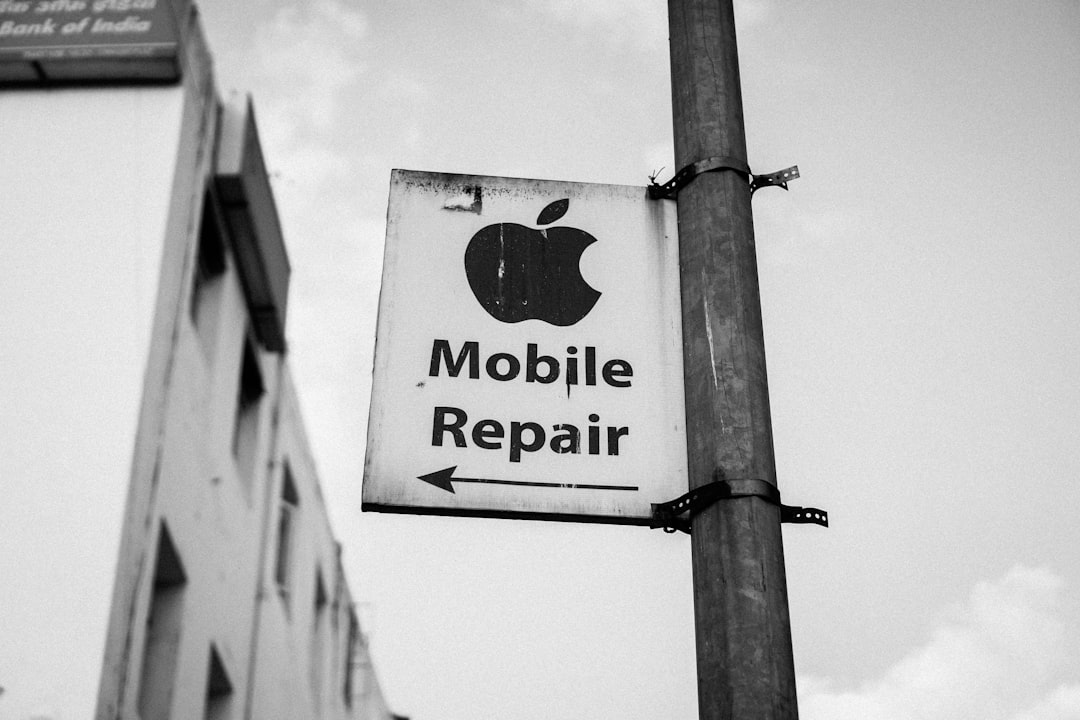

Engage prospects with a scan and streamline customer engagement with FREE QR code marketing tools by Sona – no strings attached!
Create a Free QR CodeFree consultation

No commitment

Engage prospects with a scan and streamline customer engagement with FREE QR code marketing tools by Sona – no strings attached!
Create a Free QR CodeFree consultation

No commitment
QR codes have evolved from a novelty to a strategic powerhouse in bridging offline engagement with online action. For cell phone repair services, the pressure to convert walk-in interest and fleeting in-store moments into qualified leads is constant. Traditional methods like paper forms and static signage often miss high-intent prospects, which leaves valuable opportunities untraced and sales cycles incomplete. QR codes represent a frictionless and effective way to counter these challenges: they drive repeat business, capture qualified leads that would otherwise slip through the cracks, and deliver information instantly without app downloads or complex onboarding.
Whether the goal is directing walk-in customers to book a repair, collecting feedback before they leave, or providing on-demand education about phone care, QR solutions offer a direct answer to recurring headaches like manual data entry, limited follow-up, and a lack of customer insight. By making every customer interaction both actionable and trackable, these tools help repair shops outpace competitors and meet rapidly evolving consumer expectations.
This article explores how thoughtfully deployed QR technology enables cell phone repair services to streamline operations, reduce missed leads, and enhance both conversion rates and the customer journey. The focus is practical: how to place, design, track, and optimize QR programs so every touchpoint becomes an opportunity for real engagement, insight, and growth.

Many repair shops experience frustration when high-value prospects visit their stores but leave before booking a service or submitting a form. This often occurs because traditional touchpoints fail to capture intent in real time, which results in missed opportunities, incomplete customer records, and inefficient processes. QR codes change the equation by letting customers act at the precise moment interest is highest. One scan can launch a prefilled booking, open an instant quote, or trigger a warranty registration flow that captures first-party data and sets follow-ups in motion automatically.
The impact is greatest when QR codes replace analog steps that slow people down. Instead of printed brochures that walk out the door without a trace, dynamic QR codes on signage and service counters send customers to mobile-friendly pages that you can update over time. Paper forms that are easy to abandon become quick QR-driven check-ins with autofill and one-tap consent. Manual appointment scheduling is replaced by always-available booking links that sync calendar availability in real time and reduce staff workload.
Repair business owners and marketing managers can use modern platforms like Sona QR to automate QR creation, capture intent data, and sync scan events to audience lists or a CRM. This minimizes lead leakage and ensures every prospect is recognized, nurtured, and measured across the entire lifecycle. Start creating QR codes for free.

Cell phone repair services frequently struggle with lack of visibility into customer behavior. Prospects may interact with your business physically by walking past your storefront or browsing your accessory rack, yet never leave traceable information. Since most interactions start in person and often include short windows of attention, capturing these moments before customers walk away is crucial for driving future business and building audience insights. QR codes convert these moments into measurable actions by giving people an immediate path from curiosity to commitment.
Offline-to-online friction remains a major barrier to conversion. Customers see appointment cards, window signage, counter promotions, and service menus, then must remember a web address or phone number. That additional effort often leads to abandonment. QR codes remove that friction. One scan can connect to a mobile booking form, a price estimate tool, a chat assistant, or a video that explains how water damage assessment works. These experiences can be updated dynamically after printing and can be measured so your team knows which surfaces and messages move the needle.
By consistently capturing signals from anonymous visitors and enabling seamless follow-through, QR codes pave the way for improved conversion rates, smarter investments in media, and an enhanced customer experience that meets modern expectations for speed and simplicity.

The customer journey in a repair business is fragmented. Some clients want same-day screen repair, others are researching battery replacements, and many only seek pricing or diagnosis details. The right QR code format maps each intent to a fast and relevant destination so staff do not have to intervene for every question. With the right mix, you can streamline intake, clarify options, and gather data that supports both sales and service.
Prioritize formats that match your most frequent interactions. For cell phone repair services, web links, forms, and SMS or email prefills are workhorses because they reduce the time between interest and action. vCards help customers save your contact information for future issues. App download codes support loyalty programs, repair status tracking, or device care content, which is valuable if you have a branded app.
Using dynamic QR codes is recommended for most campaigns because they provide analytics and can be updated as your promotions and services evolve. Static codes are suitable for evergreen destinations such as your homepage or a permanent care guide PDF.

Many repair businesses invest heavily in physical signage, accessories displays, and community outreach, yet struggle to attribute which assets drive online bookings or repeat business. This ambiguity causes budget waste and missed revenue because high-fit customers may interact with your message without a direct follow-up path. QR codes create a measurable bridge from these physical touchpoints to digital actions and customer records.
The key is to place QR codes where intent is naturally high. Inside your shop, customers are already motivated to act, which makes counter signage, service menus, and receipts prime real estate. Outside your shop, after-hours window decals and local ads capture people when your storefront is closed, which turns casual interest into leads you can nurture later. At events, a scan can convert foot traffic into CRM records with consent, which is valuable for building audience lists that perform in email, SMS, and retargeting channels.
Analyzing scan data over time will reveal which channels generate the highest quality bookings and reviews. Shift spend to top-performing placements and iterate on calls to action based on the messages that drive scanning. For peer insights, browse community marketing tips.

Industry experience shows that walk-in interest frequently goes unconverted because there is no frictionless way to follow up. QR codes close that gap by turning every surface into a smart prompt, so action becomes the default. When these experiences are well designed, they deliver immediate value to the customer and long-term value to the business by collecting consented data, reviews, and future-booking signals.
Three high-impact use cases consistently deliver results in cell phone repair services. Each one can be implemented with little technical complexity, yet they create outsized gains in conversion and retention. Together, they form a repeatable playbook that turns anonymous traffic into measurable demand. For inspiration, watch practical marketing tactics.
Each scan captures a valuable engagement signal, which powers retargeting and tailored outreach. For example, customers who scan education content might receive a follow-up email about an accessory bundle, while recent reviewers can be invited into a referral program.
Each QR scan is a data point that tells you something about intent, context, and timing. By deploying multiple codes across touchpoints and aligning each one with a specific journey stage, you can auto-build segments that are ready for personalized follow-up. In a repair shop, the key audience distinctions include urgency, device type, and service interest, which influence both messaging and channel selection for retargeting.
Start by separating awareness interactions from high-intent conversion points. A scan on your storefront window usually indicates curiosity or early research. A scan on an in-store price board suggests imminent purchase intent. A scan on a receipt or warranty card signals a post-purchase relationship. With Sona QR, these differences are captured as tags and attributes, then synced automatically to your CRM or ad platforms so that your campaigns are behavior-driven rather than assumption-driven.
For this industry, useful distinctions include walk-in visitors versus after-hours browsers, repair shoppers versus accessory buyers, and consumers versus small business device managers. With these segments in place, your campaigns will speak to real needs and timing, which increases conversion and reduces wasted ad spend.
QR codes do more than link to a page. They connect the dots across your offline and digital channels so engagement is captured where it begins and flows into the tools you already use. When every printed piece and screen-based message turns into a measurable digital action, attribution becomes simpler and your team can optimize based on evidence, not hunches.
In cell phone repair services, the most common media include storefront windows, counter signage, price boards, accessory displays, invoices, and local ads. Events and pop-ups at malls or community fairs are also popular. Integrating QR codes across this mix lets you maintain consistent calls to action while tailoring offers to the context. With a platform like Sona QR, you can manage codes centrally, rotate destinations as campaigns evolve, and sync analytics to your CRM.
QR codes serve as the offline onramp to your digital marketing engine. They also unlock a new layer of data collection across channels that were once difficult to measure. With a centralized platform like Sona QR, you can manage all your codes, monitor performance in real time, and sync scan data with your CRM and ad platforms to close the loop from scan to sale.
Even the best QR concept can underperform if execution gaps allow interest to go untracked or follow-ups to lag. The most successful teams treat QR campaigns as a system: clear objectives, strong creative, reliable placements, and disciplined analytics. The following checklist ensures you plan, launch, and optimize with minimal friction.
Use this workflow to align scan experiences with your shop’s growth goals. Adapt examples to your most common services and busiest channels, then iterate as data comes in. The goal is consistency: every physical surface should be a confident bridge to a digital action you can measure and improve.
Define your primary objective and the action you want customers to take. In a repair shop, typical goals include booking appointments, collecting post-repair reviews, registering warranties, and enrolling customers in loyalty programs. Make the first campaign simple so stakeholders can see immediate results.
Pick between static and dynamic codes based on your need for flexibility and analytics. Static codes work for permanent destinations that rarely change. Dynamic codes are best for campaigns, because you can track scans and change the destination link later without reprinting.
Design your codes to be on-brand and easy to scan from typical distances in your environment. Add a frame, logo, and a short, benefit-driven call to action. Test scannability on multiple devices and under different lighting conditions before rollout.
Place codes where intent and visibility are highest. In-store counter toppers, price boards, checkout areas, and repair benches are ideal for conversion actions. Window decals, A-frames, and community boards are effective for awareness and lead capture, especially after hours.
Instrument your codes with analytics and review performance frequently. Monitor scan volume, conversion rates, and drop-off points on landing pages. Run A/B tests on calls to action, incentive offers, and placement height to lift scans and bookings over time.
The right platform enables automation, minimizes missed leads, and maximizes ROI. Treat early launches as experiments, then double down on the placements and messages that consistently convert.
A persistent challenge in this industry is the disconnect between physical engagement and revenue outcomes. Shops hand out flyers or display signage but often cannot tell what drives business. Analytics close this gap by tying scans to sessions, forms, conversations, and sales. Once tracking is in place, the question shifts from Did people see it to Which assets, messages, and locations generated appointments and revenue.
Instrumentation should cover both scan events and downstream behavior. Use UTM parameters on QR destinations to attribute traffic by source and medium. Configure conversion tracking on booking forms, review submissions, and warranty registrations. Where possible, connect scan IDs to contact records so you can attribute pipeline to specific placements and creative variations. Sona QR and Sona.com together provide this full chain: Sona, an AI-powered marketing platform for identity resolution, data activation, and revenue attribution, links scan metadata to CRM enrichment and multi-touch attribution. Deepen your strategy with Sona’s guides on offline attribution, multi-touch models, and intent data.
Comprehensive analytics turn QR programs into a source of truth for marketing and operations. With visibility from scan to sale, you can justify spend, optimize quickly, and scale with confidence. Learn more at Sona.
General QR usage without a plan often leads to low scan rates and unclear impact. Shops that succeed treat QR as a repeatable system tied to a clear customer journey. They standardize calls to action, use unique codes per asset, and train staff to promote scanning with a simple explanation of the benefit. Over time, they automate follow-ups so every scan results in a relevant next step.
Choose the tactics that match your most common media and your shop’s goals. If counter traffic is your highest-intent audience, invest in prominent in-store placements and booking flows crafted for speed. If brand discovery happens through local mailers or after-hours foot traffic, prioritize window decals and QR-enabled coupons with easy redemption.
By integrating QR codes as a core component of the cell phone repair services marketing playbook, businesses can finally tie offline engagement to digital action and eliminate missed opportunities caused by anonymous traffic, manual follow-up, or outdated targeting. Whether your focus is boosting conversions, capturing every qualified lead, or building meaningful retention and upsell journeys, strategic QR campaigns turn every customer interaction into a growth opportunity. With Sona QR and Sona handling creation, routing, analytics, and attribution, every physical interaction drives a measurable digital outcome. The result is a repeatable formula for exceeding customer expectations and leading the industry forward.
QR codes have transformed cell phone repair services from simple walk-ins into dynamic, measurable growth opportunities. Whether it’s streamlining customer check-ins, providing instant access to repair status updates, or enabling targeted promotions, QR codes replace manual processes with seamless, mobile-friendly interactions that boost conversions and customer satisfaction. Imagine instantly knowing which repair offers or service reminders drive repeat business—and adjusting your campaigns on the fly to maximize results.
With Sona QR, you can create dynamic, trackable QR codes in seconds, update campaigns without reprinting flyers or receipts, and link every scan directly to revenue growth. No missed follow-ups, no guesswork—just smarter, more profitable customer engagement tailored specifically for the cell phone repair industry.
Start for free with Sona QR today and turn every scan into a loyal customer, a positive review, or your next repair appointment.
Look for repair shops that use modern tools like QR codes to streamline booking and provide transparent service information, and check for positive reviews collected through digital feedback forms.
Common services include screen repairs, battery replacements, water damage assessments, and diagnostic checklists accessible via QR code links.
Repair costs vary, but customers can often get instant quotes through QR code–enabled mobile price calculators provided by repair shops.
Use QR codes on signage, receipts, and local ads to capture leads, track customer engagement, gather reviews, and enable easy appointment booking while integrating data with CRM systems.
Check for shops that collect post-repair feedback via QR code surveys and reviews, which help maintain service standards and customer satisfaction.
Signs include cracked screens, battery issues, water damage, or device malfunctions, which can often be diagnosed or booked for repair quickly using QR code tools at repair shops.
Trust shops that provide transparent information through educational QR codes, have measurable customer reviews, and use data-driven follow-ups to ensure quality service.
The latest trends include using dynamic QR codes for real-time booking, warranty registration, feedback collection, and integrating scan data with CRM for personalized marketing.
Start by defining your service offerings, then implement QR code–based appointment systems, create measurable marketing campaigns, and use platforms like Sona QR to manage leads and customer data.
Incorporate QR codes on receipts and repair packaging linking to review forms, offer small incentives for feedback, and automate follow-ups to encourage customers to share their experiences.
Use Sona QR's trackable codes to improve customer acquisition and engagement today.
Create Your FREE Trackable QR Code in SecondsJoin results-focused teams combining Sona Platform automation with advanced Google Ads strategies to scale lead generation

Connect your existing CRM

Free Account Enrichment

No setup fees
No commitment required

Free consultation

Get a custom Google Ads roadmap for your business






Launch campaigns that generate qualified leads in 30 days or less.
